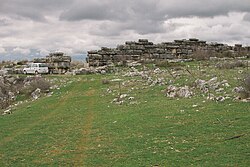Megalith

A megalith is a large stone used to build a structure or monument, either alone or together with other stones. Megalithic means structures made of such large stones, put together without the use of mortar or cement.
The word megalith comes from the Ancient Greek μέγας megas meaning great, and λίθος lithos meaning stone. It has been used to describe stone structures built by people from many parts of the world living in many different times. Many megaliths were used to figure out the dates of the solstices and equinoxes.
These structures were built mainly in the Neolithic period. They continued to be built into the Bronze Age. Some were built even earlier in the Mesolithic period.[1]
A famous example of a megalith is Stonehenge.
Megalith Media
Dolmen at Ganghwa Island, South Korea (c. 300 BC)
The largest megalith of the ancient world, found in*Baalbek, Lebanon, was quarried during the Roman Empire
Göbekli Tepe was inhabited from around 9500 BCE to at least 8000 BCE. It is one of the first manifestations of human-made monumental architecture.
Klekkende Høj passage grave, Denmark, c. 3500-2800 BC
Zorats Karer in Armenia
Daorson, Bosnia, built around a prehistoric central fortified settlement or acropolis (c. 17–16th to the end of the Bronze Age, c. 9–8th c. BCE), surrounded by cyclopean walls (similar to Mycenae) dated to the 4th c. BCE.
Notes
- ↑ Johnson, W. (1908) p.67
References
- Johnson, W. (1908). Folk-memory. Oxford: Clarendon press.










